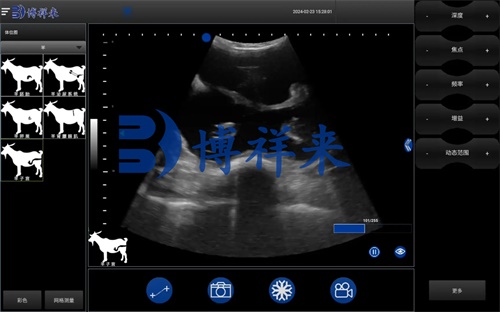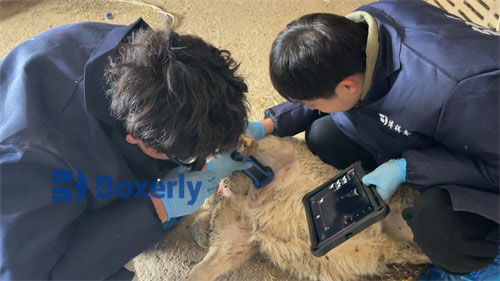Reproductive efficiency is the cornerstone of profitable meat sheep farming. In today’s global livestock industry, producers are increasingly seeking ways to improve lambing rates, reduce non-productive days, and increase the number of marketable lambs per ewe each year. One of the most effective tools to assist in this endeavor is veterinary ultrasonography. Widely adopted in sheep-producing countries such as Australia, Nueva Zelanda, and the United States, ultrasound technology offers a non-invasive, accurate, and rapid method to determine fetal numbers and assess pregnancy health in meat sheep.

En este artículo, I will explain how ultrasound is used to determine fetal numbers in ewes, its advantages over traditional palpation or observational methods, and how it contributes to better flock management decisions. I’ll also discuss breeding strategies and hormonal treatments that, when paired with ultrasonography, can help achieve the goal of producing more, higher-quality lambs per ewe per year.
Why Fetal Number Matters in Meat Sheep Farming
In meat sheep production, a ewe that gives birth to two or more healthy lambs is far more valuable than one that only produces single offspring. Twinning and multiple births reduce per-lamb production costs, increase output per ewe, and make better use of feed, labor, and land. Sin embargo, múltiple pregnancies also require careful nutritional and health management to prevent complications such as abortion, dystocia (difficult lambing), or poor lamb survival.
Knowing how many fetuses a ewe is carrying—whether one, two, or more—is therefore vital. This information allows the farmer to:
-
Adjust feed levels appropriately
-
Monitor ewes more closely during the lambing period
-
Make culling or marketing decisions for non-pregnant animals
-
Strategically time and manage lambing labor and resources
Ultrasound: A Game-Changer in Pregnancy Diagnosis
Ecografía veterinaria, particularly B-mode real-time scanners, has revolutionized how farmers monitor pregnancy in sheep. It provides a real-time image of the uterus and fetuses, allowing veterinarians or trained technicians to count fetuses with remarkable accuracy.
Most fetal number scans are performed between 40 y 80 days of gestation. Before 35 Días, it can be difficult to differentiate embryos clearly. After 80 Días, fetal size and crowding make it harder to count accurately.

Advantages of Ultrasound Over Manual Methods
Unlike traditional abdominal palpation or waiting for visible signs of pregnancy, ultrasound offers the following advantages:
-
Precision: It can reliably differentiate between single, twin, and triplet pregnancies.
-
Early detection: Ewes can be scanned early enough to make feeding and grouping decisions.
-
Real-time visualization: Scanning provides live images that can be interpreted immediately.
-
Non-invasive: No harm is done to the animal, and the procedure causes minimal stress.
-
Group management: Ewes can be sorted by fetal number into nutritional groups for more precise feeding.
Foreign producers have recognized these benefits for decades. In Australia, for instance, where large flocks are managed over vast rangelands, ultrasound pregnancy scanning is now standard practice. Many U.S. and European sheep operations also rely on this technology for flock reproductive planning.
Fetal Number Detection and Nutritional Management
Once fetal numbers are known, ewes can be managed accordingly:
-
Single-bearing ewes require lower energy intake and may be more prone to overconditioning.
-
Twin-bearing ewes need moderate supplementation to support two fetuses and prepare for lactation.
-
Triplet or higher-bearing ewes need the highest nutritional support to avoid pregnancy toxemia and to ensure good lamb birth weight and survival.
By feeding each group differently, producers avoid underfeeding (which leads to low birth weights and high mortality) and overfeeding (which increases fat deposition and lambing difficulty). This strategy also improves feed efficiency and reduces waste.
Supporting High Prolificacy: Genetics and Hormonal Control
Ultrasound scanning is only one part of a broader strategy to boost reproductive output in meat sheep. To truly increase the number of lambs per ewe, producers can also adopt genetic selection and reproductive management techniques. Here are a few widely used and proven methods:
-
Genetic Selection of Prolific Animals
-
Ram selection: Rams should be selected from prolific ewe lines—those with strong multi-lambing records. Rams must also pass semen quality and testicular health checks.
-
Ewe selection: Choose ewes from twin- or triplet-bearing families. Performance traits such as maternal behavior, milk production, and lamb survival are also important.
-
Introduction of Prolific Breeds
One fast and effective method to improve fecundity is crossbreeding with genetically prolific breeds such as the Finnsheep or Romanov. When crossed with local breeds, the offspring often inherit higher ovulation rates, leading to more multiple pregnancies.
-
Estrus Synchronization and Hormonal Control
Estrus (heat) synchronization allows a group of ewes to ovulate at the same time, facilitating timed mating and fixed-time artificial insemination. Here’s how hormone-based techniques work:
-
Vaginal sponges soaked in progesterone are inserted for 10–14 days. Once removed, ewes are injected with PMSG (Pregnant Mare Serum Gonadotropin), triggering synchronized estrus within 36 horas.
-
Prostaglandin injections, when timed correctly, can also bring ewes into estrus within 48–72 hours.
These techniques are common in European and North American sheep farms, where labor efficiency and batch lambing are prioritized.
-
Superovulation and Multiple Ovulation Protocols
To stimulate more egg release per cycle, ewes can be injected with high doses of gonadotropins like PMSG (600–1100 IU) prior to mating. On the day of estrus, HCG (Human Chorionic Gonadotropin) may also be given to improve ovulation success.
These protocols are essential in embryo transfer and AI programs, where maximizing embryo output per donor is crucial.
-
Inducing Twin or Triplet Pregnancies with Nutritional or Hormonal Support
-
Flushing: This involves feeding high-energy rations (such as grains or legumes) for 2–3 weeks before mating, increasing ovulation rates.
-
Biostimulants like “twin hormones” (also known as double-lamb stimulants) may be administered to boost multiple births. These products come in water- or oil-based injectable forms and are typically used 2–5 weeks before breeding.

How Ultrasound Scanning Enhances These Programs
When using such reproductive protocols, ultrasound plays a vital role in evaluating their effectiveness. After hormone treatments or flushing, early pregnancy scans can confirm whether multiple pregnancies occurred. The results also help refine and adjust protocols for future breeding seasons.
In embryo transfer programs, ultrasound is used both for selecting optimal donors (with visible follicles) and for confirming pregnancy in recipient ewes.
Challenges and Limitations
While ultrasound is an outstanding tool, it does have some limitations:
-
Operator skill is crucial. Inexperienced users may miscount fetuses or miss early pregnancies.
-
Equipment costs may be high for small farms, though mobile scanning services are increasingly available.
-
Late gestation scans are less accurate for fetal number and are better suited for assessing fetal viability and size.
Despite these drawbacks, the benefits overwhelmingly outweigh the challenges, especially when combined with a strong reproductive management strategy.

Conclusión
In modern meat sheep production, maximizing reproductive efficiency is not just a goal—it’s a necessity. Ultrasound scanning has become an indispensable tool in this pursuit, enabling farmers to make informed decisions about feeding, culling, and labor allocation based on accurate pregnancy and fetal number data.
When paired with sound genetic selection and hormonal control strategies, ultrasound scanning helps achieve the industry’s ultimate aim: producing more, healthier lambs per ewe, year after year.
As global demand for meat continues to rise, and producers strive to reduce waste and improve sustainability, technologies like ultrasound will continue to play a pivotal role in the future of sheep farming.